Waterproofing Options for Submersible Installations

Waterproofing Style “A” Series
Suitable For Most Ordinary Submersible Installations when installed with suitable immersion tube (a.k.a. guiderod or standpipe)

Waterproofing Style “B” Series
Suitable For the Most Aggressive Agitated Slurry Solutions & Corrosive Liquids with Complete Cable Isolation With Rugged Tubing Factory Installed
FULLY SUBMERSIBLE ASSEMBLY
WITHOUT IMMERSION TUBE

Waterproofing Style “C” Series
Suitable for Aggressive Agitated Slurry Solutions and Corrosive Liquids with additional sealing compared to “A” Series
Completely Submersible when installed with suitable immersion tube (a.k.a. guiderod or standpipe)
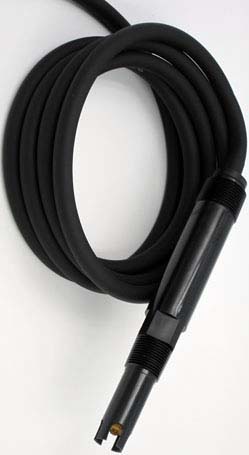
Waterproofing Style “IT” Series
Suitable For Most Submersible Applications & The Most Cost Effective Waterproofing Option
FULLY SUBMERSIBLE ASSEMBLY
WITHOUT IMMERSION TUBE
DOES MY SENSOR NEED A WATERPROOFING OPTION?
- The sealing on the back of a twist lock and immersion sensors is water resistant, but not waterproof. The standard default isolation on the back of a sensor is a strain relief grommet. This allows for the sensor to be somewhat moved and
for some minor water exposure without causing sensor failure. For more aggressive water exposure to the back of the sensor, additional precautions must be taken. - ASTI sensors are NOT intended to have rain or other continuous exposure of water on the back of the cable without a waterproofing seal installed.
GENERAL COMMENTS ON SELECTION OF WATERPROOFING OPTIONS
- The waterproofing options offer anywhere from nominal isolation to extremely robust isolation in the following order going from least isolating to most isolating:
- WPIT/WPITC << WPA/WPG << WPC << WPB/WPH
- Comparison Chart of Waterproofing Options Shown Below
- Most users will only ever require the WPIT, WPA, WPC or WPB options but the WPITC, WPG & WPH versiond with a CPVC material of constructionfor use in the presence of certain oxidizing chemicals are also available.
- In general, the WPB or WPH sealing is only really required for fully submersible type installations.
- Note that ONLY the WPIT/WPITC and WPB/WPH waterproofing sealing options provide for COMPLETE cable isolation all the way back to the transmitter.
If you should have any doubt about whether the exact sensor model that you are using is appropriate for the installation style that you are planning to implement, please contact the factory for further assistance!
Option “A” – Waterproofing Style “A” Series

Angle view of AB 6410 Ammonium ISE sensor
with WPA submersible option installed
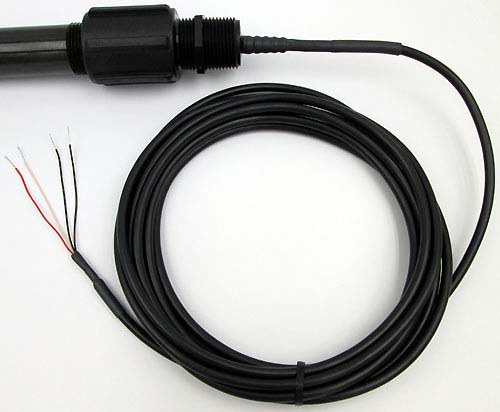
WPA on sensor without preamplifier
shown in 1″MNPT rear thread size

Close-up rear view of WPA submersible option
Download Line Drawing of Waterproofing “A” Series
Suitable For Most Ordinary Completely Submersible Installations
Option Available For:
- 3/4″ MNPT Rear Threaded Immersion Sensors
- 6X11, 6X13, 6X12, 6X53, 6X54, 6X32 & 6X42 Series pH/ORP Sensors
- 3/4″ MNPT Rear Threaded Sanitary/HOT-TAP Sensors
- 5X31, 5X41 & 5X51 pH/ORP Series Sensors
- 5XX0 Ion Selective (ISE) Series Sensors
- AST-DO-UNIVERSAL Dissolved Oxygen (DO) Series Sensors in the universal and sanitary/HOT-TAP configurations
- 1″ MNPT Rear Threaded Immersion Sensors
- 6X52, 6X51, 6X31 & 6X41 Series pH/ORP Sensors
- 6XX0 Series Ion Selective (ISE) Series Sensors
- 1″ MNPT Read Threaded Twist Lock Sensors with protective tines (guard) option added
- 8X52, 8X51, 8X31 & 8X41 Sensor pH/ORP Series
- 8XX0 Series Ion Selective (ISE) Series Sensors
- AST-DO-UNIVERSAL Dissolved Oxygen (DO) Series Sensors in the twist lock quick disconnect configuration
- 1-1/4″ MNPT Read Threaded Immersion Sensors
- AB 6100 Fluoride Ion Selective Sensors Only
Features & Recommended Applications:
- Complete isolation of back end threaded fitting from liquid process and good protection of cable from corrosion and chemical attack
- Rear threading is identical to that specified on original sensor specifications prior to application of Waterproofing “A” Option
- Hex Head for wrench flats enable easy installations into fixtures
- Not recommended for extremely corrosive installations or installations which do not utilizes any kind of guide rod or conduit
- Recommended primarily for elongating sensor life where attack of liquid from back end causes death to sensor prior to chemical or physical attack through front of probe
- For Applications Requiring Waterproofing Assemblies to be constructed of only CPVC (for strong oxidative or reducing solutions – i.e. chlorine, chlorine dioxide, strong hydrogen peroxide or ozone solutions… etc.); Change Waterproofing part description from Waterproofing “A” to “G”
BEST PRACTICE FOR INLINE USE
INDOOR:
If a standard sensor such as the immersion or twist lock sensor series is used for inline installations and no immersion or submersible use is planned then no special precautions are required if it is for indoor use. This assumes that the back of the sensor will not be exposed to corrosive gas present and/or the plant will not cause any process media to get onto the back of the sensor, nor give it significant water exposure by washing down the area.
OUTDOOR:
If a standard sensor such as an immersion or twist lock sensor series is used for inline installations and no immersion or submersible use is planned then there generally ARE special precautions required for outdoor inline use. The most common is to seal the back end of the sensor in conduit to isolate the back end of the sensor. The most common approach so to use sufficient TEFLON tape and a NPT coupling to create this back sensor seal, and then either a rigid or flexible conduit back to the transmitter where is the lead wires are terminated for cable isolation. This creates a barrier that makes the sensor suitable for conditions were rain and other outdoor elements could damage the seal on the back of the sensor. Specifically, this can prevent water from attacking along the sensor cable and causing internal shorting to solder joins inside the unit itself. Another approach for sealing the back of the sensor if there will be significant water exposure is to add a waterproofing option. In general, for such cases just the least expensive WPIT option is which sufficient provided that tubing is properly installed. The WPIT waterproofing option has a slight surcharge for extended cable lengths. In some cases the more robust WPA option can also be used to fulfill this purpose. Unfortunately waterproofing options cannot be added once a sensor has been fabricated but rather must be installed at the time of manufacture.
BEST PRACTICE FOR IMMERSION USE
Immersion use is defined as when the sensor is immersed into the process media, but the entire sensor is not submersed. This mean that the back of the sensor is NOT completely below the process media level. Immersion installations always require the back of the sensor/waterproofing to be sealed with a mating FNPT coupling and the cable run in conduit. The WPIT, WPA or WPC waterproofing options can be added if desired/required to make the sensor life better even for such immersion installations. It is possible to use the standard immersion or twist lock sensor for immersion use without adding a waterproofing option if VERY GOOD care is taken to seal the back of the sensor with a coupling and properly running the cable in conduit back to the transmitter.
BEST PRACTICE FOR FULLY SUBMERSIBLE USE
Submersible use is defined as when the sensor is COMPLETELY immersed into the process media (anywhere from 1 feet below the fluid level to much much deeper). In this case the entire sensor IS submersed. This mean that the back of the sensor is COMPLETELY below the process media level. Submersible installations always require the back of the sensor/waterproofing to be sealed with a mating NPT coupling and the cable run in conduit. For additional sealing option a WPA, WPC or WPB waterproofing option can be added if desired/required. There is a special surcharge if the sensor has a longer cable length that the standard 5 feet for the WPIT and WPB waterproofing options only. It is possible to use the standard immersion or twist lock sensor for submersible use without adding a waterproofing option is VERY, VERY GOOD care is taken to seal the back of the sensor with a coupling and properly running the cable in conduit back to the transmitter. The use of Waterproofing Option WPA, WPB or WPC is VERY STRONGLY recommended (although not strictly required) for submersible installations.
Option “B” – Waterproofing Style “B” Series

Angle view of 3/4″MNPT rear threads with WPB submersible option

Side close-up view of 3/4″MNPT rear threads with WPB submersible option

Wide view of AB 6100 Fluoride ISE sensor with WPH submersible option & integral preamplifier, 10 feet vinyl tubing & Q7M snap connector

Download Line Drawing of Waterproofing “B” Series
Suitable For the Most Aggressive Agitated Slurry Solutions and Corrosive Liquids – Recommended for Installations without guide rod or conduit – Direct Insertion into volatile tank – COMPLETE CABLE ISOLATION WITH VINYL OR NORPRENE TUBING & NO METAL PARTS WHATSOEVER
Option Available For:
- 3/4″ MNPT Rear Threaded Immersion Sensors
- 6X11, 6X13, 6X12, 6X53, 6X54, 6X32 & 6X42 Series pH/ORP Sensors
- 3/4″ MNPT Rear Threaded Sanitary/HOT-TAP Sensors
- 5X31, 5X41 & 5X51 pH/ORP Series Sensors
- 5XX0 Ion Selective (ISE) Series Sensors
- AST-DO-UNIVERSAL Dissolved Oxygen (DO) Series Sensors in the universal and sanitary/HOT-TAP configurations
- 1″ MNPT Rear Threaded Immersion Sensors
- 6X52, 6X51, 6X31 & 6X41 Series pH/ORP Sensors
- 6XX0 Series Ion Selective (ISE) Series Sensors
- 1″ MNPT Read Threaded Twist Lock Sensors with protective tines (guard) option added
- 8X52, 8X51, 8X31 & 8X41 Sensor pH/ORP Series
- 8XX0 Series Ion Selective (ISE) Series Sensors
- AST-DO-UNIVERSAL Dissolved Oxygen (DO) Series Sensors in the twist lock quick disconnect configuration
- 1-1/4″ MNPT Read Threaded Immersion Sensors
- AB 6100 Fluoride Ion Selective Sensors Only
Features & Recommended Applications:
- Complete isolation of back end threaded fitting from liquid process and good protection of cable from corrosion and chemical attack
- Major Rear threading is identical to that specified on original sensor specifications prior to application of Waterproofing “B” Option
- Hex Head for wrench flats enable easy installations into fixtures
- Recommended for extremely corrosive installations or installations which do not utilizes any kind of guide rod or conduit, or extremely slurry/viscous solutions which can abraid cable assemblies
- Recommended primarily for elongating sensor life where attack of liquid from back end causes death to sensor prior to chemical or physical attack through front of probe
- For Applications Requiring Waterproofing Assemblies to be constructed of only CPVC (for strong oxidative or reducing solutions – i.e. chlorine, chlorine dioxide, strong hydrogen peroxide or ozone solutions… etc.); Change Waterproofing part description from Waterproofing “B” to “H” (as shown in photos to right)
BEST PRACTICE FOR INLINE USE
INDOOR:
If a standard sensor such as the immersion or twist lock sensor series is used for inline installations and no immersion or submersible use is planned then no special precautions are required if it is for indoor use. This assumes that the back of the sensor will not be exposed to corrosive gas present and/or the plant will not cause any process media to get onto the back of the sensor, nor give it significant water exposure by washing down the area.
OUTDOOR:
If a standard sensor such as an immersion or twist lock sensor series is used for inline installations and no immersion or submersible use is planned then there generally ARE special precautions required for outdoor inline use. The most common is to seal the back end of the sensor in conduit to isolate the back end of the sensor. The most common approach so to use sufficient TEFLON tape and a NPT coupling to create this back sensor seal, and then either a rigid or flexible conduit back to the transmitter where is the lead wires are terminated for cable isolation. This creates a barrier that makes the sensor suitable for conditions were rain and other outdoor elements could damage the seal on the back of the sensor. Specifically, this can prevent water from attacking along the sensor cable and causing internal shorting to solder joins inside the unit itself. Another approach for sealing the back of the sensor if there will be significant water exposure is to add a waterproofing option. In general, for such cases just the least expensive WPIT option is which sufficient provided that tubing is properly installed. The WPIT waterproofing option has a slight surcharge for extended cable lengths. In some cases the more robust WPA option can also be used to fulfill this purpose. Unfortunately waterproofing options cannot be added once a sensor has been fabricated but rather must be installed at the time of manufacture.
BEST PRACTICE FOR IMMERSION USE
Immersion use is defined as when the sensor is immersed into the process media, but the entire sensor is not submersed. This mean that the back of the sensor is NOT completely below the process media level. Immersion installations always require the back of the sensor/waterproofing to be sealed with a mating FNPT coupling and the cable run in conduit. The WPIT, WPA or WPC waterproofing options can be added if desired/required to make the sensor life better even for such immersion installations. It is possible to use the standard immersion or twist lock sensor for immersion use without adding a waterproofing option if VERY GOOD care is taken to seal the back of the sensor with a coupling and properly running the cable in conduit back to the transmitter.
BEST PRACTICE FOR FULLY SUBMERSIBLE USE
Submersible use is defined as when the sensor is COMPLETELY immersed into the process media (anywhere from 1 feet below the fluid level to much much deeper). In this case the entire sensor IS submersed. This mean that the back of the sensor is COMPLETELY below the process media level. Submersible installations always require the back of the sensor/waterproofing to be sealed with a mating NPT coupling and the cable run in conduit. For additional sealing option a WPA, WPC or WPB waterproofing option can be added if desired/required. There is a special surcharge if the sensor has a longer cable length that the standard 5 feet for the WPIT and WPB waterproofing options only. It is possible to use the standard immersion or twist lock sensor for submersible use without adding a waterproofing option is VERY, VERY GOOD care is taken to seal the back of the sensor with a coupling and properly running the cable in conduit back to the transmitter. The use of Waterproofing Option WPA, WPB or WPC is VERY STRONGLY recommended (although not strictly required) for submersible installations.
Option “C” – Waterproofing Style “C” Series

Front view of model PNCGR 8331/8131/8631-3081HT-25-WPC Submersible High Temperature Slurry Resistant pH Sensor sensor with WPC sealing option & integral analog preamplifier with tinned lead wire terminations

Side view of WPC submersible option sealing assembly
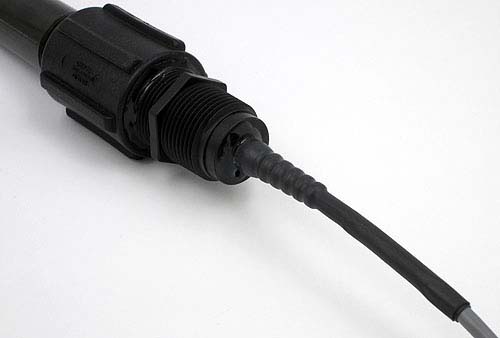
Rear view close-up on sealing portion of WPC submersible assembly
Download Line Drawing of Waterproofing “C” Series
Suitable For the Most Aggressive Agitated Slurry Solutions and Corrosive Liquids
Recommended for similar Installations as Waterproofing Style “B” – Lacks the complete Cable Isolation offered by “B” Style
Option Available For:
- 3/4″ MNPT Rear Threaded Immersion Sensors
- 6X11, 6X13, 6X12, 6X53, 6X54, 6X32 & 6X42 Series pH/ORP Sensors
- 3/4″ MNPT Rear Threaded Sanitary/HOT-TAP Sensors
- 5X31, 5X41 & 5X51 pH/ORP Series Sensors
- 5XX0 Ion Selective (ISE) Series Sensors
- AST-DO-UNIVERSAL Dissolved Oxygen (DO) Series Sensors in the universal and sanitary/HOT-TAP configurations
- 1″ MNPT Rear Threaded Immersion Sensors
- 6X52, 6X51, 6X31 & 6X41 Series pH/ORP Sensors
- 6XX0 Series Ion Selective (ISE) Series Sensors
- 1″ MNPT Read Threaded Twist Lock Sensors with protective tines (guard) option added
- 8X52, 8X51, 8X31 & 8X41 Sensor pH/ORP Series
- 8XX0 Series Ion Selective (ISE) Series Sensors
- AST-DO-UNIVERSAL Dissolved Oxygen (DO) Series Sensors in the twist lock quick disconnect configuration
- 1-1/4″ MNPT Read Threaded Immersion Sensors
- Special Order Basis Only
Features & Recommended Applications:
- Complete isolation of back end threaded fitting from liquid process and good protection of cable from corrosion and chemical attack
- Rear threading is identical to that specified on original sensor specifications prior to application of Waterproofing “C” Option
- Hex Head for wrench flats enable easy installations into fixtures
- Not Recommended for extremely installations which do not utilizes any kind of guide rod or conduit
- Recommended for extremely corrosive and/or slurry, viscous or high-speed process solutions which can abraid cable assemblies
- Recommended primarily for elongating sensor life where attack of liquid from back end causes death to sensor prior to chemical or physical attack through front of probe
BEST PRACTICE FOR INLINE USE
INDOOR:
If a standard sensor such as the immersion or twist lock sensor series is used for inline installations and no immersion or submersible use is planned then no special precautions are required if it is for indoor use. This assumes that the back of the sensor will not be exposed to corrosive gas present and/or the plant will not cause any process media to get onto the back of the sensor, nor give it significant water exposure by washing down the area.
OUTDOOR:
If a standard sensor such as an immersion or twist lock sensor series is used for inline installations and no immersion or submersible use is planned then there generally ARE special precautions required for outdoor inline use. The most common is to seal the back end of the sensor in conduit to isolate the back end of the sensor. The most common approach so to use sufficient TEFLON tape and a NPT coupling to create this back sensor seal, and then either a rigid or flexible conduit back to the transmitter where is the lead wires are terminated for cable isolation. This creates a barrier that makes the sensor suitable for conditions were rain and other outdoor elements could damage the seal on the back of the sensor. Specifically, this can prevent water from attacking along the sensor cable and causing internal shorting to solder joins inside the unit itself. Another approach for sealing the back of the sensor if there will be significant water exposure is to add a waterproofing option. In general, for such cases just the least expensive WPIT option is which sufficient provided that tubing is properly installed. The WPIT waterproofing option has a slight surcharge for extended cable lengths. In some cases the more robust WPA option can also be used to fulfill this purpose. Unfortunately waterproofing options cannot be added once a sensor has been fabricated but rather must be installed at the time of manufacture.
BEST PRACTICE FOR IMMERSION USE
Immersion use is defined as when the sensor is immersed into the process media, but the entire sensor is not submersed. This mean that the back of the sensor is NOT completely below the process media level. Immersion installations always require the back of the sensor/waterproofing to be sealed with a mating FNPT coupling and the cable run in conduit. The WPIT, WPA or WPC waterproofing options can be added if desired/required to make the sensor life better even for such immersion installations. It is possible to use the standard immersion or twist lock sensor for immersion use without adding a waterproofing option if VERY GOOD care is taken to seal the back of the sensor with a coupling and properly running the cable in conduit back to the transmitter.
BEST PRACTICE FOR FULLY SUBMERSIBLE USE
Submersible use is defined as when the sensor is COMPLETELY immersed into the process media (anywhere from 1 feet below the fluid level to much much deeper). In this case the entire sensor IS submersed. This mean that the back of the sensor is COMPLETELY below the process media level. Submersible installations always require the back of the sensor/waterproofing to be sealed with a mating NPT coupling and the cable run in conduit. For additional sealing option a WPA, WPC or WPB waterproofing option can be added if desired/required. There is a special surcharge if the sensor has a longer cable length that the standard 5 feet for the WPIT and WPB waterproofing options only. It is possible to use the standard immersion or twist lock sensor for submersible use without adding a waterproofing option is VERY, VERY GOOD care is taken to seal the back of the sensor with a coupling and properly running the cable in conduit back to the transmitter. The use of Waterproofing Option WPA, WPB or WPC is VERY STRONGLY recommended (although not strictly required) for submersible installations.
Option “IT” – Waterproofing Style “IT” Series

6X61 series smart digital pH sensor with WPIT polypropylene submersible option & 10 feet NORPRENE tubing; 20 feet green cable with HiQ4m snap connector

Rear close-up of 6X61 analog sensor with WPIT polypropylene sealing & NORPRENE tubing installed; Fully submersible to 115 degrees Celsius Max

Front view of 5X31 series sensor with WPITC CPVC submersible option & 10 feet vinyl tubing & tinned lead wire terminations

Side view of WPITC CPVC submersible option sealing assembly
Download Line Drawing of Waterproofing “IT” Series
Suitable For Most Applications and the Most Cost Effective Waterproofing Option
COMPLETE CABLE ISOLATION WITH VINYL OR NORPRENE TUBING & NO METAL PARTS WHATSOEVER
Option Available For:
- 3/4″ MNPT Rear Threaded Immersion Sensors
- 6X11, 6X13, 6X12, 6X53, 6X54, 6X32 & 6X42 Series pH/ORP Sensors
- 3/4″ MNPT Rear Threaded Sanitary/HOT-TAP Sensors
- 5X31, 5X41 & 5X51 pH/ORP Series Sensors
- 5XX0 Ion Selective (ISE) Series Sensors
- AST-DO-UNIVERSAL Dissolved Oxygen (DO) Series Sensors in the universal and sanitary/HOT-TAP configurations
- 1″ MNPT Rear Threaded Immersion Sensors
- 6X52, 6X51, 6X31 & 6X41 Series pH/ORP Sensors
- 6XX0 Series Ion Selective (ISE) Series Sensors
- 1″ MNPT Read Threaded Twist Lock Sensors with protective tines (guard) option added
- 8X52, 8X51, 8X31 & 8X41 Sensor pH/ORP Series
- 8XX0 Series Ion Selective (ISE) Series Sensors
- AST-DO-UNIVERSAL Dissolved Oxygen (DO) Series Sensors in the twist lock quick disconnect configuration
- 1-1/4″ MNPT Read Threaded Immersion Sensors
- AB 6100 Fluoride Ion Selective Sensors Only
Features & Recommended Applications:
- Complete isolation of back end threaded fitting from liquid process and good protection of cable from corrosion and chemical attack
- Major Rear threading is identical to that specified on original sensor specifications prior to application of Waterproofing “IT” Option
- Suitable For Applications and the Most Economical and Cost Effective of our Waterproofing Options
- Recommended primarily for elongating sensor life where attack of liquid from back end causes death to sensor (typically by corrosion along cable) prior to chemical or physical attack through front of probe
- For Applications Requiring Waterproofing Assemblies to be constructed of only CPVC (for strong oxidative or reducing solutions – i.e. chlorine, chlorine dioxide, strong hydrogen peroxide or ozone solutions… etc.); Change Waterproofing part description from Waterproofing “WPIT” to “WPITC” (as shown in photos to right)
BEST PRACTICE FOR INLINE USE
INDOOR:
If a standard sensor such as the immersion or twist lock sensor series is used for inline installations and no immersion or submersible use is planned then no special precautions are required if it is for indoor use. This assumes that the back of the sensor will not be exposed to corrosive gas present and/or the plant will not cause any process media to get onto the back of the sensor, nor give it significant water exposure by washing down the area.
OUTDOOR:
If a standard sensor such as an immersion or twist lock sensor series is used for inline installations and no immersion or submersible use is planned then there generally ARE special precautions required for outdoor inline use. The most common is to seal the back end of the sensor in conduit to isolate the back end of the sensor. The most common approach so to use sufficient TEFLON tape and a NPT coupling to create this back sensor seal, and then either a rigid or flexible conduit back to the transmitter where is the lead wires are terminated for cable isolation. This creates a barrier that makes the sensor suitable for conditions were rain and other outdoor elements could damage the seal on the back of the sensor. Specifically, this can prevent water from attacking along the sensor cable and causing internal shorting to solder joins inside the unit itself. Another approach for sealing the back of the sensor if there will be significant water exposure is to add a waterproofing option. In general, for such cases just the least expensive WPIT option is which sufficient provided that tubing is properly installed. The WPIT waterproofing option has a slight surcharge for extended cable lengths. In some cases the more robust WPA option can also be used to fulfill this purpose. Unfortunately waterproofing options cannot be added once a sensor has been fabricated but rather must be installed at the time of manufacture.
BEST PRACTICE FOR IMMERSION USE
Immersion use is defined as when the sensor is immersed into the process media, but the entire sensor is not submersed. This mean that the back of the sensor is NOT completely below the process media level. Immersion installations always require the back of the sensor/waterproofing to be sealed with a mating FNPT coupling and the cable run in conduit. The WPIT, WPA or WPC waterproofing options can be added if desired/required to make the sensor life better even for such immersion installations. It is possible to use the standard immersion or twist lock sensor for immersion use without adding a waterproofing option if VERY GOOD care is taken to seal the back of the sensor with a coupling and properly running the cable in conduit back to the transmitter.
BEST PRACTICE FOR FULLY SUBMERSIBLE USE
Submersible use is defined as when the sensor is COMPLETELY immersed into the process media (anywhere from 1 feet below the fluid level to much much deeper). In this case the entire sensor IS submersed. This mean that the back of the sensor is COMPLETELY below the process media level. Submersible installations always require the back of the sensor/waterproofing to be sealed with a mating NPT coupling and the cable run in conduit. For additional sealing option a WPA, WPC or WPB waterproofing option can be added if desired/required. There is a special surcharge if the sensor has a longer cable length that the standard 5 feet for the WPIT and WPB waterproofing options only. It is possible to use the standard immersion or twist lock sensor for submersible use without adding a waterproofing option is VERY, VERY GOOD care is taken to seal the back of the sensor with a coupling and properly running the cable in conduit back to the transmitter. The use of Waterproofing Option WPA, WPB or WPC is VERY STRONGLY recommended (although not strictly required) for submersible installations.
Waterproofing Options Comparison Chart
The matrix of submersible option is based upon three factors:WPB, WPH & WPIT/WPITC onlyMaterial of ConstructionPolypropylene (PP) or CPVCFamily of Waterproofing Option Invoked
Type & length of sealing hose installed

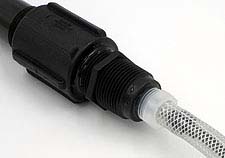
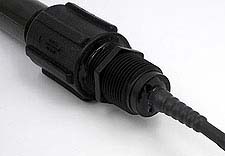

| Description of Waterproofing Option | Material | Family “A” Standard Submersible with Standpipe | Family “B” Fully Submersible with Cable Isolation | Family “C” Fully Submersible with Standpipe | Family “IT” Submersible with Cable Isolation |
| Most Submersible Applications | PP | WPA | WPB | WPC | WPIT |
| Halogen (Chlorine) & Oxidizer Resistant Applications | CPVC | WPG | WPH | Not Available | WPITC |
![]() Download the Complete Printable Waterproofing Product Brochure (PDF)
Download the Complete Printable Waterproofing Product Brochure (PDF)
GENERAL NOTES ABOUT WATERPROOFING OPTIONS:
- The length of installed tubing is recommended not to exceed 65% of the total cable length for best results.
- All options are available for sensors with 3/4″ MNPT, 1.0″ MNPT or 1.25″ MNPT rear threads.
- Max temperature for continuous usage of the polypropylene (PP) waterproofing options is 105 degrees Celsius (220 degrees Fahrenheit).
- Max temperature for continuous usage of the CPVC waterproofing options is 90 degrees Celsius (195 degrees Fahrenheit).
- The waterproofing with the polypropylene (PP) material of construction are the best choice for most applications. There are some selected process solutions that contain chemicals for which CPVC is a better choice than PP such as in some strong oxidizers such as chlorine and chlorine dioxide as well as diluted nitric acid. In general, however, the PP material of construction is a better choice for chemical resistance, particularly if organic solvents may be present.
- All waterproofing types are suitable for use in outdoor installations where rain and moisture may be present on a continuous basis. All waterproofing options are also suitable for facilities that perform washdowns such that the back of the sensor may become thoroughly wetted.
- The WPA and WPC sealing should use an immersion tube sealing to the rear NPT threads of the waterproofing feature for fully submersible use.
- The WPB, WPH, WPIT series waterproofing can be installed with either 3/8″X5/8″ braid reinforced vinyl tubing or NORPRENE® polypropylene tubing to allow for fully submersible installation without the use of an immersion tube (a.k.a. standpipe or guide rod).
- The NORPRENE® polypropylene tubing is primarily intended to be employed for locations where the entire cable assembly will be exposed to the 105 degrees Celsius (including the hose) or else for process media that is incompatible with vinyl tubing. The NORPRENE® polypropylene hose installation assembly includes a special NYLON clamp to act as a secondary securing feature although the factory installation of the NORPRENE® polypropylene hose results in a very reliable seal even without use the optional NYLON clamp.
- Total tubing desired for WPB, WPH & WPIT is indicated with /XX suffix for vinyl tubing and /XXPP suffix for the NORPRENE® polypropylene tubing where XX is the length of hose in feet. Typically the maximum supported hose length possible is 35 feet (10.7 meters). Inquire to factory if a hose length longer than 35 feet is required for your installation.
